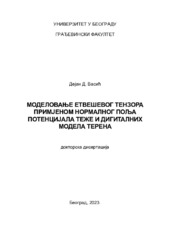Приказ основних података о документу
Modelovanje Etveševog tenzora primenom normalnog polja potencijala teže i digitalnih modela terena
| dc.contributor.advisor | Odalović, Oleg | |
| dc.contributor.other | Blagojević, Dragan | |
| dc.contributor.other | Grekulović, Sanja | |
| dc.creator | Vasić, Dejan D. | |
| dc.date.accessioned | 2023-11-23T12:06:27Z | |
| dc.date.available | 2023-11-23T12:06:27Z | |
| dc.date.issued | 2023 | |
| dc.identifier.uri | https://grafar.grf.bg.ac.rs/handle/123456789/3270 | |
| dc.description.abstract | Предмет овог рада је истраживање могућности моделовања градијената убрзања теже Земље, елемената тзв. Етвешевог тензора. Анализирани концепт подразумијева моделовање које се врши без коришћења било каквих резултата гравиметријских или сличних мјерења. Умјесто тога, модел се искључиво ослања на директно моделовање утицаја маса тијела Земље. Масе су подијељене на три дијела, масу нормалне Земље, топографске масе и масе између геоида и елипсоида. Утицај масе нормалне Земље срачунат је на основу нормалног поља и других извода нормалног потенцијала теже, док су друга два сегмента моделована њиховом дискретизацијом и апроксимацијом помоћу призми као правилних геометријских тијела. У ту сврху коришћени су дигитални модели терена и званични модел квазигеоида, као и глобални геопотенцијални модели. Практично истраживање спроведено је за територију Србије. У директној провјери модела, срачунати градијенти су упоређени са резултатима мјерења торзионом вагом у полигону код Новог Сада. За стандардно одступање градијената добијене су вриједности од 15 E – 20 E, односно 1.5 Gal/m - 2 Gal/m . Вертикални градијенти су тестирани на основу мјерења широм Србије, те је утврђено стандардно одступање од око 230 E. За све градијенте срачунате су и вриједности из глобалног геопотенцијалног модела, те је утврђено да на изразито равничарском терену имају исту или бољу сагласност са мјерењима у односу на вриједности из модела. Модел је тестиран и посредно, у оквиру гравиметријког полигона у Бору, рачунањем компоненти одступања вертикала из моделованих градијената. Ове вриједности упоређене су са компонентама оцијењеним из званичног модела квазигеоида. Установљена је врло добра сагласност оцијењених компоненти са познатим, уз стандардно одступање мање од једне лучне секунде по компоненти. На основу ових резултата извшена је оцјена тачности градијената, те су за њихова стандардна одступања добијене вриједности од 30 E – 40 E. Добијени резултати су показали да је примјеном предложеног концепта могуће остварити тачност моделовања градијената на нивоу тачности мјерења, или за један ред величине мању. На крају су дата додатна запажања о оствареној тачности и потенцијалним изворима грешака, као и препоруке за даља истраживања и унапређење модела. | sr |
| dc.description.abstract | The subject of this thesis is research into the possibility of modeling Earth’s gravity gradients, the elements of the so-called of the Eöetvös tensor. The analyzed concept implies modeling that is performed without using any results of gravimetric or similar measurements. Instead, the model relies exclusively on forward modeling of the effects of the Earth's masses. The masses are divided into three parts, the mass of the normal Earth, the topographic masses and the masses between the geoid and the ellipsoid. The influence of the mass of the normal Earth was calculated on the basis of the normal gravity field and second derivatives of the normal gravity potential, while the other two segments were modeled by their discretization and approximation using prisms as regular geometric bodies. For this purpose, digital terrain models and the official quasigeoid model, as well as global geopotential models, were used. Practical research was conducted for the territory of Serbia. In the direct verification of the model, the calculated gradients were compared with the results of torsion balance measurements in the polygon near Novi Sad. For the standard deviation of the gradients, values of 15 E - 20 E were obtained, that is, . Vertical gravity gradients were tested based on measurements across Serbia, and a standard deviation of about 230 E was determined. For all gradients, values from the global geopotential model were also calculated, and it was determined that on extremely flat terrain they have the same or better agreement with measurements compared to modeled values. The model was also tested indirectly, within the gravimetric polygon in Bor, by calculating the vertical deflections components based on modeled gradients. These values were compared with the components estimated from the official quasigeoid model. A very good agreement of the evaluated components with the known ones was established, with a standard deviation of less than one arcsecond per component. Based on these results, the accuracy of the gradients was evaluated, and values of 30 E - 40 E were obtained for their standard deviations. The obtained results showed that by applying the proposed concept, it is possible to achieve the accuracy of modeling gradients at the level of measurement accuracy, or one order of magnitude lower. At the end, additional observations are given about the achieved accuracy and potential sources of errors, as well as recommendations for further research and improvement of the model. | sr |
| dc.language.iso | sr | sr |
| dc.relation | info:eu-repo/grantAgreement/MESTD/MPN2006-2010/18005/RS// | |
| dc.rights | openAccess | sr |
| dc.rights.uri | https://creativecommons.org/licenses/by-nc-nd/4.0/ | |
| dc.subject | поље теже Земље | sr |
| dc.subject | потенцијал убрзања теже | sr |
| dc.subject | градијенти | sr |
| dc.subject | Етвешев тензор | sr |
| dc.subject | градиометрија | sr |
| dc.subject | дигитални модели терена | sr |
| dc.subject | одступања вертикала | sr |
| dc.subject | Earth's gravity field | sr |
| dc.subject | gravity acceleration potential | sr |
| dc.subject | gradients | sr |
| dc.subject | Eöetvös tensor | sr |
| dc.subject | gradiometry | sr |
| dc.subject | digital terrain models | sr |
| dc.subject | vertical deflections | sr |
| dc.title | Modelovanje Etveševog tenzora primenom normalnog polja potencijala teže i digitalnih modela terena | sr |
| dc.type | doctoralThesis | sr |
| dc.rights.license | BY-NC-ND | sr |
| dc.identifier.fulltext | http://grafar.grf.bg.ac.rs/bitstream/id/12304/bitstream_12304.pdf | |
| dc.identifier.rcub | https://hdl.handle.net/21.15107/rcub_grafar_3270 | |
| dc.type.version | publishedVersion | sr |

